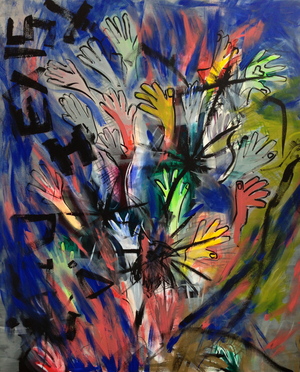At first glance, a painting can mystify us. Our initial reaction to a great work of art will often be solidified, challenged, or turned upside down by investigating the more nuanced clues within the canvas. We look harder, noting the artist's use of color, line and composition, hoping the image will direct us along some path to unlocking its mystery. Collectors and art lovers often appreciate most those images, which incite this desire to engage with the work. The most successful pieces make us aware of what we DON'T know, rather than what we do.
The journey of painting began about 40,000 years of ago, when the caveman dipped their hands in animal blood to mark the walls of their caves, as if to say: I am here, I exist. Since then so much has changed, yet all the while, our journey as a human kind has been documented with millions and millions of brush strokes and paint smears. The tragedies and the achievements of the protagonists of the human story have been captured through the arts.
When I look at a painting, I try to disregard who the artist was, or year the work was created; rather, I try to figure out its place in our human journey by connecting innocently with the emotive aspects of the work. I make note of my feelings as I examine a work of art, knowing that my emotions will be the vehicle that can drive me through the artwork and will help me understand it.
For example, I was just recently in Madrid and visited The Museum of El Prado. Walking down the majestic corridors of the museum, I came across a painting called Saturn Devouring His Son by Goya. The painting is part of a group of works referred to as "The Black Paintings," created by the artist from 1819-1823 in his villa at Quinto del Sordo. Goya's work from this time indulges in the macabre, using fantastically morbid imagery, which at once reflects the mental state of the artist (as at this time he was struck with an illness which rendered him deaf), as well as the internal strife in his native Spain.

"Saturn Devouring His Son," is no different. It portrays Saturn, the Roman mythological character, eating his children for fear they would one day overthrow him. The image is grotesque, Saturn appearing demonic, deranged, panicked and confused. It is as if he cannot stop himself from committing this unspeakable act of cruelty and violence, his own fear of demise overcoming his sacred bond with his own offspring.
Goya's painting was created nearly 2,000 years after the Roman's canonized the myth of Saturn; however, despite the great discrepancy in the historical timeline, the image perfectly represents exactly the same fear to the unknown, failure, confusion and loss. When I looked at the image on the walls of the Prado, I felt those same emotions, which allowed me to unlock the artwork, and understand its timeless message about humanity.

